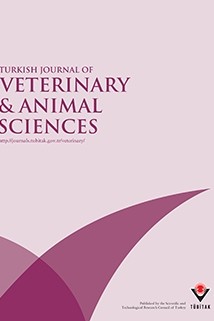
Turkish Journal of Veterinary and Animal Sciences
Yazarlar: Ulvi Reha FİDANCI, Fügen TURGAY, Seda ZENGİN
Konular:-
Anahtar Kelimeler:Angora goats,Genotype,Antioxidative metabolism
Özet: In this study, lipid peroxidation, intracellular, membrane and extracellular antioxidant activities in Turkish Angora goats (Genotype I) and American x Turkish crossbred Angora goats (Genotype II) were investigated, in order to show the effects of genotype on the antioxidative metabolism. Plasma malonlydialdehyde (MDA) levels of Angora goats in different genotype were analyzed to show the effects of free radicals. Glutathione peroxidase (GSH-Px), superoxide dismutase (SOD) and catalase (CAT) activities in hemolysates of erythrocytes were analyzed as intracellular antioxidants, b-carotene in serum as membrane antioxidants and ascorbic acid in plasma, albumin, total bilirubin, glucose, uric acid and ceruloplasmine in serum as extracellular antioxidants to determine the change in the antioxidative metabolism. Plasma MDA levels in American x Turkish crossbred Angora goats (Genotype II) were found to be significantly higher than the plasma MDA levels in Turkish Angora goats (Genotype I) (p < 0.05). Erythrocyte GSH-Px and SOD activities in American x Turkish crossbred Angora goats (Genotype II) were found to be significantly lower than the erythrocyte GSH-Px and SOD activities in Turkish Angora goats (Genotype I) (p < 0.001). However, activities of CAT in Turkish x American crossbred Angora goats (Genotype II) were found to be significantly higher than the activities of CAT in Turkish Angora goats (p < 0.01). There were no statistically significant differences between the serum b-carotene, plasma ascorbic acid, serum albumin, bilirubin and glucose levels of Angora goats in different genotypes (p ? 0.05). Significant decreases were found both in serum uric acid (p < 0.001) and ceruloplasmin (p < 0.05) levels of Angora goats in genotype II. It was concluded that improving the productivity by genotypical variation in animal breeding may affect the antioxidative metabolism. The increasing peroxidative metabolism in American x Turkish crossbred Angora goats affected the intracellular antioxidants of the antioxidative metabolism. However, extracellular antioxidant responses were limited to the increasing peroxidative metabolism in genotype II. These findings showed that extracellular and membrane antioxidants are secondary antioxidants.